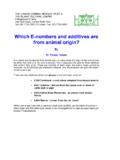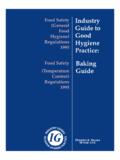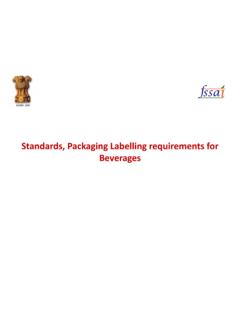Transcription of Food Safety Industry Guide to Hygiene) Good …
1 food Safety Industry (General food Guide to Hygiene) Good Regulations Hygiene 1995. Practice: food Safety Catering (Temperature Guide Control). Regulations 1995. Chadwick House Group Ltd. food Safety and Hygiene Working Group All graphs/diagrams Crown copyright Crown copyright is reproduced with the permission of the Controller of Her Majesty's Stationery Office. Applications for reproduction should be made to Chadwick House Group Ltd. First impression 1997. ISBN 0 900 103 00 0. P UBLI SHED BY CHADW I CK HOUSE GROUP LTD. Chadwick Court 15 Hatfields London SE1 8DJ. Tel: 0171 827 5882 Main switchboard: 0171 827 9929 Fax: 0171 827 9930. Chadwick House Group Ltd. (CHGL) is a commercial company, wholly owned by the Chartered Institute of Environmental Health (CIEH). The company's mission is to provide quality products and services to create awareness and to raise standards in the health environment and Safety of the public.
2 We intend to remain the premier provider by continual investment in our people, products and services in support of the aims of the CIEH. Our main activities are focused on training, communications and conferences and exhibitions. It also markets a wide selection of books and videos relating to environmental health. The CIEH is a professional and educational body, founded in 1883 and dedicated to the promotion of environmental health and to encouraging the highest possible standards in the training and the work of environmental health officers. The Chartered Institute has over 9,000 members most of whom work for local authorities in England, Wales and Northern Ireland. Apart from providing services and information to members, the Institute also advises government departments on environmental health and is consulted by them on any proposed legislation relevant to the work of environmental health officers.
3 The Chartered Institute is a Registered Charity. Part 1 Preface Chapter 0 Chapter Heading This Industry Guide to good hygiene practice gives advice to catering businesses on how to comply with the food Safety (General food Hygiene) Regulations 1995. This is an official Guide to the Regulations which has been developed in accordance with article 5 of the EC Directive on the hygiene of foodstuffs (93/43/EEC). This Guide also contains advice on how to comply with the food Safety (Temperature Control) Regulations 1995. Whilst this Guide has no legal force, food authorities must give it due consideration when they enforce the Regulations. It is hoped that the information which this Guide contains will help you both to meet your legal obligations and to ensure food Safety . Note: The Industry Guide to Good Hygiene Practice : Catering Guide was originally published in September 1995.
4 This revised edition gives guidance on the food Safety (General food Hygiene) Regulations 1995 and now includes guidance on the food Safety (Temperature Control). Regulations 1995. The guidance on the food Safety (General food Hygiene) Regulations has not been altered. The guidance on the food Safety (Temperature Control). Regulations can also be purchased separately, from the publishers of this Guide , Chadwick House Group Ltd. iii Part 1 Acknowledgements Chapter 0 Chapter Heading The JHIC is indebted to the members of the food Safety and Hygiene Working Group who developed this Guide : Representing BLRA. Tom Miller (Chairman of the working group) Whitbread plc Carolyn Smethurst Allied Domecq Leisure Representing BHA. David Clarke Forte Purchasing Nicki Rees Compass Services (UK) Ltd Clive Wadey Compass Retail Catering Representing Dept.
5 Of Health John Barnes Representing HCIMA. Robin Osner Robin Osner Associates Jennie Stokell Jennie Stokell Catering Management Representing LACOTS. Mark du Val Representing RAGB. David Harrold Secretary to the JHIC. Phil Phillips The JHIC is grateful to all those members of its Associations who read the drafts and commented during the development process. In addition, all the valuable contributions received during the public consultation exercise were much appreciated. Finally, thanks must go to Catherine MacDonald and Michelle Haylock for their software and keyboard skills. iv Part 4 Contents Chapter I General requirements for food premises Page Part 1 Introduction 1. General introduction 1. Scope of the Guide 2. List of JHIC members & Acknowledgments 3. Part 2 Identification of steps critical to food Safety (Regulation 4[3]) 4.
6 The legal requirement to identify hazards and to take steps to control them Part 3 Training 9. The legal requirement for supervision and instruction and/or training of food handlers Part 4 The Rules of Hygiene': A detailed Guide to the requirements of Schedule 1 of the food Safety (General food Hygiene) Regulations 199516. Chapter I General requirements for the structure of food premises 17. Chapter II Specific requirements for walls/floors and other surfaces in food preparation rooms and the equipment provided 22. Chapter III Requirements for movable and/or temporary premises (such as marquees, market stalls, mobile sales vehicles), premises used primarily as a private dwelling house, premises used occasionally for catering purposes and vending machines 28. Chapter III[A] Mobile or temporary food premises, and premises used only occasionally 29.
7 Chapter III[B] Vending machines 32. Chapter III[C] Domestic premises used for commercial food preparation 35. Chapter IV The transport of food 38. Chapter V Construction and installation of equipment 41. Chapter VI The disposal of food waste 43. Chapter VII Water supply for use in food and for cleaning 45. Chapter VIII The rules of personal hygiene for anyone entering or working in food premises (includes advice on Regulation 5) 47. Chapter IX Hygiene rules for the handling of foodstuffs 49. Part 5 Temperature Controls Guide to Compliance with the food Safety (Temperature Control). Regulations 1995 53. Summary of provisions 54. Section 1 - England & Wales (Regulations 4-12) 55. Section 2 - Scotland (Regulations 13-16) 65. Annex: Practical Temperature Control of food in Catering Premises 71.
8 Part 6 Glossary, References and Contact addresses 91. References: Other Regulations and documents mentioned in this Guide 91. Contacts: Useful contact addresses 92. Glossary: Definitions of some of the terms used in the Guide 93. v Part 1 Introduction Chapter 0 Chapter Heading Guide to Compliance by Caterers This booklet is a Guide for caterers on compliance with the food Safety (General food Hygiene) Regulations 1995 [FS(GFH)R 1995], the food Safety (Temperature Control) Regulations 1995 [FS(TC)R 1995] and the equivalent regulations in Northern Ireland. It has been developed in accordance with Article 5 of the Directive 93/43/EEC and the preparation of this Guide followed the 'Template' from the Department of Health (September 1994). The Guide has the status implied by Reg. 8(2)(c) of FS(GFH)R 1995.
9 Enforcement officers must give due consideration' to the Guide when assessing compliance. The Guide deals only with the FS(GFH)R 1995 and the FS(TC)R 1995. Many other Acts or Regulations will govern the sale of food by caterers, and some may have a bearing on general food hygiene issues. For example, water supply (Schedule 1, Chapter VII) must also comply with water bye-laws;. hygienic practices must also be consistent with Health & Safety requirements; date marking of supplies is dictated by food labelling regulations; and so on. There is specific cross-reference to other legal provisions in some parts of the Guide , but it was impractical for this cross referencing to be comprehensive. SCOPE & ORGANISATIONS: Listed on page 2 are the types of catering operation covered by the Guide , which was drafted by members of the Joint Hospitality Industry Congress (JHIC).
10 A list of the organisations involved in the JHIC is given at the end of this part of the Guide . Throughout, food ' includes drink and CATERING' is taken to include any sale or supply of food or drink for human consumption, including alcoholic drinks or soft drinks. COMPLIANCE: The Guide provides detailed, point by point, information on the legal requirements as they would be interpreted in catering premises. The primary objective of this Guide is to give comprehensive guidance on legal compliance. This Guide sets out recommended means by which caterers may comply with the Hygiene Regulations. It may, of course, be possible for a business to demonstrate to enforcers that it has achieved the objectives of the Regulations in other ways. GOOD PRACTICE/ food QUALITY: The Guide gives additional information about points of good practice and factors that may affect food quality rather than Safety .






